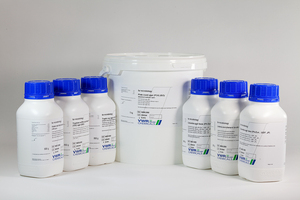VWR 2,3,5-Triphenyltetrazolium Chloride (Ttc), Technical, 10g
Catalog No :
CAS Number :
Brand :
In Stock
Formula: C₁₉H₁₅ClN₄
CAS Number: 298-96-4
Specifications:
| Storage Temperature | 2-8°C | ||
| Product Type | Biochemical Reagent | Forms | Powder |
| Product Brand | VWR | ||
| Product Grade | Analytical grade | Formula | C₁₉H₁₅ClN₄ |
VWR® 2,3,5-Triphenyltetrazolium Chloride (TTC), Technical Grade, is a widely recognized biochemical reagent extensively utilized in microbiological, biochemical, agricultural, and clinical research applications. Supplied in a practical 10 g quantity, TTC functions primarily as a sensitive redox indicator, used for assessing cell viability, enzyme activity, and microbial respiration through a characteristic colorimetric reaction.
Chemical Specifications
- Chemical Name: 2,3,5-Triphenyltetrazolium Chloride
- Commonly Known As: TTC
- CAS Number: 298-96-4
- Grade: Technical grade
- Molecular Formula: C19H15ClN4
- Molecular Weight: 334.80 g/mol
- Appearance: White to pale-yellow crystalline powder
- Solubility: Water-soluble; readily soluble in methanol, ethanol, acetone, and aqueous buffer solutions.
Principle and Mechanism of Action
TTC is a colorless tetrazolium salt that acts as an electron acceptor in biochemical reactions. Metabolically active microorganisms, cells, or enzymes reduce TTC enzymatically via respiratory chain enzymes (especially dehydrogenases) to form red, insoluble triphenylformazan (TPF) crystals.
The distinct red color of the formazan produced provides a clear indication of metabolic and enzymatic activity, enabling accurate and convenient visual or spectrophotometric quantification.
Applications and Detailed Use Cases
1. Microbial Viability and Enumeration Assays
Primary Use:
- Rapid evaluation of microbial viability and enumeration of active bacterial colonies.
Practical Example:
- Microbiology laboratories routinely incorporate TTC into agar media (e.g., plate count agar with TTC) to visually distinguish viable bacterial colonies by their characteristic red coloration, facilitating precise enumeration in water, food, clinical, or environmental samples.
2. Seed Viability and Germination Testing
Primary Use:
- Assessment of seed viability and germination potential through rapid enzymatic activity detection.
Practical Example:
- Agricultural researchers employ TTC assays on seeds (such as maize, soybean, wheat) to verify seed viability. Viable seeds enzymatically reduce TTC to produce red-stained embryos, providing immediate visual confirmation of seed health and viability status.
3. Tissue Viability and Pathological Studies
Primary Use:
- Evaluation of tissue viability, infarction, and cell damage in biomedical and pathological studies.
Practical Example:
- Biomedical researchers utilize TTC staining on animal tissues (e.g., myocardial infarction models). Healthy, metabolically active tissue reduces TTC to a bright red formazan, while damaged or necrotic tissues remain pale, clearly indicating regions of tissue damage and infarction.
4. Enzyme Activity and Metabolic Assays
Primary Use:
- Rapid measurement of mitochondrial enzyme activities, metabolic capacity, and dehydrogenase activity in biochemical research.
Practical Example:
- Researchers investigating mitochondrial respiration incubate isolated mitochondria or enzyme preparations with TTC. Formation of red formazan crystals provides quantitative data on enzyme function, respiratory capacity, and metabolic activity.
5. Environmental and Soil Microbial Respiration Testing
Primary Use:
- Measurement and visualization of microbial respiration and metabolic activity in environmental samples (soil, sediments, wastewater).
Practical Example:
- Environmental microbiologists employ TTC in soil respiration assays to detect microbial metabolic activity. Soils undergoing active microbial respiration convert TTC into visually identifiable red formazan, providing clear evidence of microbial activity and ecological health.
Advantages and Key Benefits
- Simple, Visual Results: Easy-to-interpret red formazan coloration enables rapid qualitative and quantitative analysis.
- Versatile Applications: Widely applicable across microbiological, agricultural, clinical, and environmental research areas.
- Reliable Technical Grade: Cost-effective quality suitable for routine laboratory, educational, and research applications.
- Convenient Packaging: Practical 10 g quantity ideal for small-to-medium scale research or educational laboratories.
Storage, Stability, and Handling
- Store tightly sealed in a cool, dry place (recommended: refrigerated storage at 2–8°C).
- Protect from exposure to moisture, direct sunlight, and contamination.
- Follow standard laboratory safety guidelines when handling and disposing of chemical reagents.
Intended Users
- Microbiology, agriculture, and environmental laboratories
- Clinical and pathology research laboratories
- Universities and educational institutions conducting biochemical research
- Agricultural research institutions and seed testing laboratories
- Biomedical researchers evaluating tissue viability and metabolic functions
VWR® 2,3,5-Triphenyltetrazolium Chloride (TTC), Technical Grade, 10 g, offers researchers and laboratory professionals a dependable, cost-effective reagent for accurate and efficient assessment of microbial, cellular, enzymatic, and tissue viability. Its reliability, ease of use, and broad applicability make it a fundamental tool for numerous laboratory analyses and experimental workflows.




 0
0



